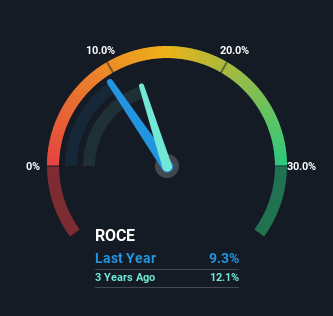
There are a few key trends to look for if we want to identify the next multi-bagger. Firstly, we'd want to identify a growing return on capital employed (ROCE) and then alongside that, an ever-increasing base of capital employed. Basically this means that a company has profitable initiatives that it can continue to reinvest in, which is a trait of a compounding machine. In light of that, when we looked at SEB (EPA:SK) and its ROCE trend, we weren't exactly thrilled.
Understanding Return On Capital Employed (ROCE)
Just to clarify if you're unsure, ROCE is a metric for evaluating how much pre-tax income (in percentage terms) a company earns on the capital invested in its business. To calculate this metric for SEB, this is the formula:
Return on Capital Employed = Earnings Before Interest and Tax (EBIT) ÷ (Total Assets - Current Liabilities)
0.093 = €547m ÷ (€9.1b - €3.2b) (Based on the trailing twelve months to December 2022).
So, SEB has an ROCE of 9.3%. Ultimately, that's a low return and it under-performs the Consumer Durables industry average of 14%.
See our latest analysis for SEB

Above you can see how the current ROCE for SEB compares to its prior returns on capital, but there's only so much you can tell from the past. If you're interested, you can view the analysts predictions in our free report on analyst forecasts for the company.
How Are Returns Trending?
The trend of ROCE doesn't look fantastic because it's fallen from 13% five years ago, while the business's capital employed increased by 26%. Usually this isn't ideal, but given SEB conducted a capital raising before their most recent earnings announcement, that would've likely contributed, at least partially, to the increased capital employed figure. It's unlikely that all of the funds raised have been put to work yet, so as a consequence SEB might not have received a full period of earnings contribution from it.
The Bottom Line
Bringing it all together, while we're somewhat encouraged by SEB's reinvestment in its own business, we're aware that returns are shrinking. Since the stock has declined 24% over the last five years, investors may not be too optimistic on this trend improving either. Therefore based on the analysis done in this article, we don't think SEB has the makings of a multi-bagger.
One more thing: We've identified 2 warning signs with SEB (at least 1 which is a bit unpleasant) , and understanding them would certainly be useful.
For those who like to invest in solid companies, check out this free list of companies with solid balance sheets and high returns on equity.
New: Manage All Your Stock Portfolios in One Place
We've created the ultimate portfolio companion for stock investors, and it's free.
• Connect an unlimited number of Portfolios and see your total in one currency
• Be alerted to new Warning Signs or Risks via email or mobile
• Track the Fair Value of your stocks
Have feedback on this article? Concerned about the content? Get in touch with us directly. Alternatively, email editorial-team (at) simplywallst.com.
This article by Simply Wall St is general in nature. We provide commentary based on historical data and analyst forecasts only using an unbiased methodology and our articles are not intended to be financial advice. It does not constitute a recommendation to buy or sell any stock, and does not take account of your objectives, or your financial situation. We aim to bring you long-term focused analysis driven by fundamental data. Note that our analysis may not factor in the latest price-sensitive company announcements or qualitative material. Simply Wall St has no position in any stocks mentioned.
About ENXTPA:SK
SEB
Designs, manufactures, and markets small domestic equipment in Western Europe, rest of Europe, the Middle East, Africa, North and South America, China, and rest of Asia.
Good value with adequate balance sheet and pays a dividend.
Similar Companies
Market Insights
Community Narratives




